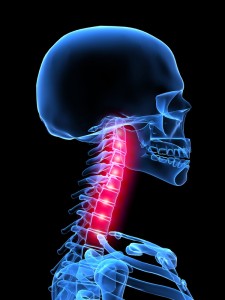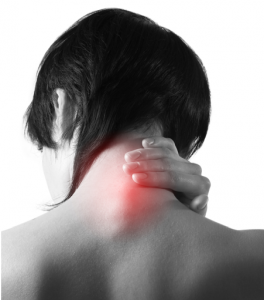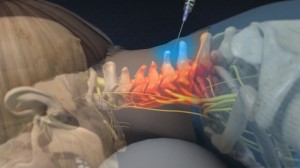Neck pain is very common and may result after an auto accident, injury at work or sports injury. Here are 10 ways to avoid the need for neck surgery.
1. Analgesics: Non-steroidal anti-inflammatory drugs (NSAIDs) reduce pain at low doses  and alleviate inflammation at high doses. They are first-line treatment of most cervical spine (neck) disorders.
and alleviate inflammation at high doses. They are first-line treatment of most cervical spine (neck) disorders.
2. Muscle relaxers: Muscle relaxers such as carisoprodol (Soma), cyclobenzaprine (Flexeril) or diazepam (Valium). This is not really a class of drugs but each of the muscle relaxants acts on the central nervous system (brain) to produce overall relaxation. They should be limited to short-term use to alleviate muscle spasm.
If a person is involved in an auto accident, a personal injury doctor may want to prescribe these medications on a short term basis for relief.
3. Narcotics: For short-term use in severe neck pain, narcotic medications (opioids) are appropriate. These may include: codeine (Tylenol #3), hydrocodone (Vicodin) and oxycodone (Percocet, Oxycontin).
4. Therapeutic modalities: Hot packs or ice may be used to relieve spasm and pain. They are intended to provide short-term relief. The use of transcutaneous nerve stimulation (TENS) and ultrasound are additional therapeutic modalities designed for temporary pain control.
5. Physical therapy: A physical therapist is able to analyze whether there is postural mal-alignment and help to correct it. A physical therapist will also instruct a patient in terms of appropriate flexibility and strengthening exercises. Stretching exercises can help preserve as well as increase the range of motion in affected cervical (neck) joints, and thus relieve the stiffness that leads to pain.
Neck stretching is best done every day. Researchers believe that strength-training may help generate new muscle in place of injured tissue. Specific strengthening exercises will  help maintain improved posture, which in turn will lessen or eliminate recurrent flare-ups of pain. A physical therapist can also help to mobilize tight ligaments and manipulate joint structures.
help maintain improved posture, which in turn will lessen or eliminate recurrent flare-ups of pain. A physical therapist can also help to mobilize tight ligaments and manipulate joint structures.
6.Cervical traction: Cervical traction has been in use for centuries. The goal of cervical traction is to distract the individual cervical vertebrae and thus relieve pressure on spinal nerves due to disc bulge or herniation. Manual cervical traction can be performed by a physical therapist. A physical therapist can instruct the individual patient in use of a home cervical traction unit. Approximately seven to ten pounds of cervical traction is applied for one hour three times per day. The procedure also helps reduce muscle spasms.
7. Medications for nerve root irritation: Certain medications are particularly helpful for nerve root irritation. Anti-depressants, especially tricyclic anti-depressants, can block pain signals due to nerve pain. Other neuropathic medications include: Neurontin, Lyrica and Cymbalta. A short course of oral corticosteroids can significantly reduce pain due to nerve root inflammation.
8. Spinal injections: Epidural steroid injections target the inflamed nerve root directly. Performed with the aid of fluoroscopy (an x-ray technique which visualizes the spinal  structures), a high dose of cortisone is injected to the area of the nerve root as it emerges from the spinal canal. This type of injection is typically repeated three times for maximal benefit. More than three are not recommended due to possible deleterious effects on the spinal structures.
structures), a high dose of cortisone is injected to the area of the nerve root as it emerges from the spinal canal. This type of injection is typically repeated three times for maximal benefit. More than three are not recommended due to possible deleterious effects on the spinal structures.
9. Other types of injections: Selective nerve root blocks with local anesthetic can also be injected around the inflamed nerve root and thus reduce pain. If the facet joints are suspected to be the pain generator, cortisone with or without local anesthetic can be  injected into the joints themselves. If this type of injection relieves neck pain, a rhizotomy procedure which ablates the sensory nerve to the facet can provide long term pain relief.
injected into the joints themselves. If this type of injection relieves neck pain, a rhizotomy procedure which ablates the sensory nerve to the facet can provide long term pain relief.
10. Alternative medicine: Acupuncture, massage and yoga are useful adjuncts to neck pain treatment.






Leave A Comment